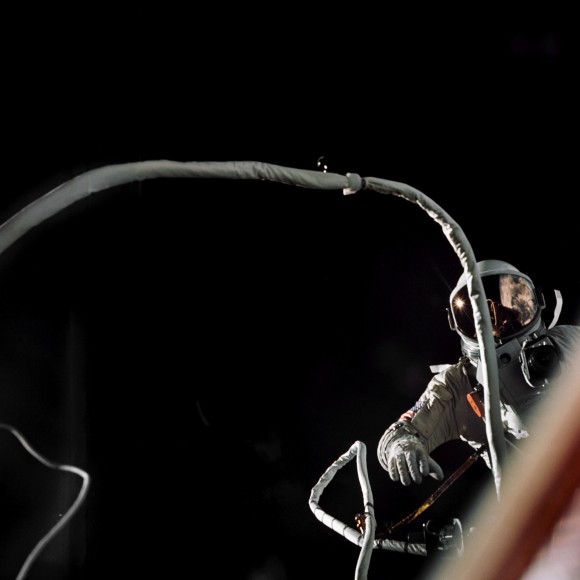
Almost five decades ago, one of the hairiest and most difficult missions in America’s space history unfolded. Gemini IX-A was already complex—a three-day flight, involving rendezvous, docking, maneuvering, and spacewalking—but had endured additional challenges: the death of its prime crew in an aircraft accident and the destruction of its primary docking target in a launch failure. A replacement target, known as the Augmented Target Docking Adaptor (ATDA), had been hastily launched, but its own docking collar had only partially opened and remained attached to the vehicle. On 3 June 1966, Gemini IX-A crewmen Tom Stafford and Gene Cernan flew into orbit, ready for trouble.
They acquired a good radar lock on their quarry—nicknamed “The Blob”—and at first it seemed that the docking collar might have successfully separated. Unfortunately, as Gemini IX-A drew closer, it became clear that it was actually gaping, half-open, like an enormous pair of jaws. “It looks like an angry alligator,” Stafford told Mission Control with dismay. Initial hope that he might be able to nudge it with his spacecraft’s nose to fully open the jaws was rejected as too risky by Flight Director Gene Kranz, and Stafford was forced to station-keep at a distance of about 35 feet away. It was clear, he reported, that the ATDA’s explosive bolts had fired, but two neatly-taped lanyards stubbornly held the shroud in place. The high tensile strength of these lanyards made it inadvisable to nudge the jaws. Moreover, Gemini IX-A’s parachutes were housed in its nose and damaging them was unthinkable.
On the ground, at a strategy meeting that night with senior managers Bob Gilruth and Chris Kraft, Gemini IX-A backup pilot Buzz Aldrin suggested sending Cernan outside to manually clip the lanyards with a pair of surgical scissors. Astronauts Jim McDivitt and Dave Scott, in Los Angeles, Calif., at the time, were despatched to prime contractor Douglas Aircraft’s plant to examine a duplicate ATDA and determine if this could be done. Their consensus: It was possible, but would leave many sharp edges which could tear Cernan’s suit. Also, the tumbling of the ATDA, the almost-complete lack of EVA experience, and the dangers of the explosive bolts holding the lanyards together posed their own risks.
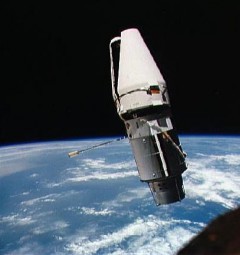
In the meantime, efforts by controllers to tighten and relax The Blob’s docking cone, in the hope that the action might free the shroud, were unsuccessful. “That only pushed out the bottom part of the shroud,” wrote Cernan in his autobiography, The Last Man on the Moon, “and forced the other end, which was open, to partially close. Contracting the collar had the reverse effect, and to us, it seemed that those moving jaws were opening and closing.” The alligator seemed to be laughing at their misfortune.
After the mission, it would become clear that the problem centered on the fact that the Agena, the ATDA, and the shroud were built by three different organizations, namely Lockheed, McDonnell, and Douglas. Before McDonnell technicians had made a final inspection on the ATDA at Cape Kennedy, Fla., a Douglas engineer had supervised a practice run, with the exception of the lanyards which controlled the electrical disconnect to the explosive bolts. In the interests of safety, the lanyards were not hooked up for the test.
Crucially, the Douglas engineer was then forced to return home and tend his pregnant wife, telling his McDonnell counterpart to “secure the lanyards.” Consequently, on launch day, the McDonnell crew followed procedures published by Lockheed, which had themselves been copied from Douglas documentation. The instructions referred to a blueprint which was not present, and the absence of the engineer meant that those technicians responsible for fixing the ATDA’s shroud simply wondered what to do with the dangling lanyards and decided that their best and safest bet was to tape them down. It was those taped-down lanyards which had now ruined Stafford and Cernan’s target in orbit. It was a classic example of the old metaphor Too many cooks spoil the broth.
In the meantime, five hours into the Gemini IX-A mission, Stafford nosed his spacecraft “down” by 90 degrees and fired his forward thrusters for 35 seconds to slightly increase his speed and drop “above” the ATDA. Simulating a failed radar, they then plotted their position with an on-board sextant, notepad, and pencil, checked their results against a pre-planned chart solution, and commenced a series of four maneuvers to bring themselves back into a station-keeping stance with the target. It was far from easy and, wrote Cernan, represented “a bitch of an exercise that demanded unimagined mental and physical effort.” Nonetheless, six and a half hours after launch, they were finally in the vicinity of The Blob, only to depart again shortly thereafter for a third exercise. To prepare for this, at 3:55 p.m. EST, a little over seven hours into the mission, Stafford again pulsed the thrusters to reduce speed and widen the gap between Gemini IX-A and the ATDA.
By now exhausted, the two astronauts checked their systems, took an opportunity to gobble some toothpaste-like mush of chicken and dumplings—“No crumbs that way,” wrote Cernan, but “not much taste, either”—and tried with little success to sleep. Awakened in the small hours of 4 June to begin their second day in orbit, they were almost immediately immersed in the third rendezvous: reducing the size of their orbit to again intercept the still-laughing Blob. By rendezvousing with an object “beneath” them, Stafford and Cernan would mimic the procedures to be followed by an Apollo command module pilot tasked with rescuing a lunar module stuck in a low orbit around the Moon. Phase and height adjustments, followed by a thruster burn, reduced the gap between themselves and the target. “The mental perception was that we were falling straight down to Earth,” Cernan recalled years later, “and we did not even see the gator until we were within three miles of it.” Stafford, too, later admitted to sensations of mild vertigo. At this point, Stafford spotted what appeared to be “a pencil dot on a sheet of paper” and would point out that, had it not been for the radar, the rendezvous would have failed. The rendezvous was completed at 6:21 a.m., and Stafford and Cernan withdrew from the ATDA at 7:38 a.m.
The two men felt justifiably proud: They had conducted no fewer than three rendezvous in less than a day. However, their work had taken its toll. Both were exhausted, as, indeed, was their spacecraft, whose fuel supply had dwindled to less than 10 percent after the marathon rendezvous effort. Ahead, later on 4 June, lay Cernan’s spacewalk, but Stafford donned his commander’s cap and told Mission Control that the excursion should be postponed. “We’ve been busier than left-handed paper-hangers up here,” he drawled. “I’m afraid it would be against my better judgment to go ahead and do the EVA at this time … Perhaps we should wait until tomorrow morning.” For the first time, Cernan wrote, a pair of astronauts had seemingly “questioned” their duties and, although not a military organization, some within NASA felt that they were quitting. Yet there was little doubt that Stafford and Cernan were best placed to know the situation inside their spacecraft, and Capcom Neil Armstrong duly responded that their recommendation had been accepted. Armstrong would later describe Stafford’s actions as reflecting “exceptionally good judgment.”
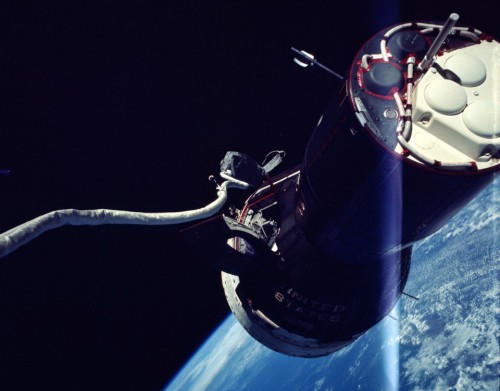
As a result, the EVA was moved to 5 June and the remainder of the day was spent focusing upon Gemini IX-A’s experiments and ensuring that both men were fully rested. Original plans, dating back to before the deaths of Elliot See and Charlie Bassett, called for the Gemini IX spacewalker to spend at least two hours outside, remove a large, armchair-like Astronaut Maneuvering Unit (AMU) from its housing at the back of the spacecraft’s adaptor, and test it. He was supposed to retrieve a micrometeorite package from the original Agena target craft, although this was scratched from the flight plan when the target ended up at the bottom of in the Atlantic, following a launch accident discussed in yesterday’s article. A new plan to remove a micrometeorite detector from the ATDA was also called off when it proved impossible to execute a docking.
Still, preparations for the excursion were intense. Early on 5 June, Stafford lowered Gemini IX-A’s orbit while Cernan pulled his chest pack down from a shelf above his left shoulder, strapped it on, and plugged in an umbilical tether which would provide him with oxygen, communications, and electrical power. Since the whole cabin would be reduced to vacuum, Stafford also had to be protected, and both men laboriously clicked their helmet visors shut, pulled on heavy gloves, and pressurized their suits until they went, in Cernan’s words, “from soft to rock-hard around our bodies.” Yet Cernan’s suit had much more insulation and protection than that of Stafford. “Out where I was going,” he wrote, “the temperature in unfiltered sunlight would be many times hotter than any desert at high noon on Earth, while the nighttime cold could freeze steel until it was as brittle as glass.” Approaching dawn on their 31st orbit, the men received permission to go ahead, and at 10:02 a.m. Cernan twisted the handle above his head and the huge hatch swung outward.
Words clearly defied even the normally chatterbox Cernan at this point as he pushed himself “upwards,” stood on his seat, and rode “like a sightseeing bum on a boxcar” toward the California coastline. Hollering “hallelujah” at the top of his voice, he would later describe the glorious, ever-changing sight as like “sitting on God’s front porch,” as orbital darkness gave way to the first stirring of dawn. There was little time to sightsee. With Stafford holding onto his foot to steady him, Cernan set to work positioning a television camera and retrieving a nuclear emulsion package which recorded radiation levels and measured the impact of space dust. Next, he affixed a small mirror onto Gemini IX-A’s nose, so that Stafford could watch as he made his way toward the AMU at the rear of the spacecraft.
Unlike Ed White, he was not equipped with a hand-held zip-gun, and he quickly set to work on his next task: to evaluate his ability to maneuver himself around by tugging at his snake-like tether. It would, he wrote, teach him new lessons about Newton’s laws of motion. “My slightest move would affect my entire body, ripple through the umbilical, and jostle the spacecraft,” Cernan explained. “Since I had nothing to stabilize my movements, I went out of control, tumbling every which way, and when I reached the end of the umbilical, I rebounded like a bungee jumper, and the snake reeled me in as it tried to resume its original shape.” As he looped around Gemini IX-A, the experience was comparable to wrestling an octopus, and Cernan’s only chance at controlling his motions came when he managed to grab the tether tightly at the point at which it emerged from the hatch.
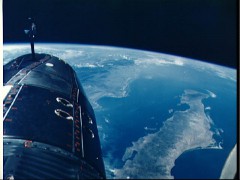
After half an hour of helplessness, he seized a handrail and pulled himself toward Gemini IX-A to rest. Clearly, he said, future spacewalkers would need propulsion and more handholds; otherwise they would be unable to prevent themselves from flopping around like rag dolls on the end of their tethers. Cernan’s rest break was brief: He had to reach the back of the spacecraft before the arrival of orbital dusk to strap on the AMU, exchange his oxygen umbilicals for those attached to the rocket armchair, and commence the next phase of his spacewalk. His move to the rear of Gemini IX-A was far harder than he could have anticipated. The stiff, bulky suit fought his every move and lacked the flexibility and mobility that he desperately needed.
Nonetheless, Cernan labored, hand-over-hand, halting at times to loop his tether through small eyelets and thus keep it from damage. Finally, he reached the adaptor at the back of the spacecraft and, swinging himself around it, disappeared from view in Stafford’s mirror. The Sun, too, vanished as Gemini IX entered orbital darkness over South Africa.
Working in near-pitch blackness, Cernan flicked on a pair of lights—only one of which worked, yielding a glow little more effective than a candle—and prepared to activate the AMU. Thirty-five meticulous steps lay between him and achieving the goal of becoming the first human satellite—steps ranging from pushing buttons to opening valves and disconnecting, then reconnecting, his oxygen supply. His heart rate, which reached 155 beats per minute when he arrived at the adaptor section, showed no signs of slowing as Cernan puzzled over why he had been able to accomplish the task with ease in a parabolic aircraft and yet the real thing was leaving him exhausted, drenched with sweat, and almost blind. At last, he flipped the last switch and prepared to take the AMU on its maiden outing.
All was far from being well. A hundred minutes into the spacewalk, Cernan was scarcely able to see through his fogged-up visor—the suit’s environmental control system was struggling and failing to absorb the humidity and exhaled carbon dioxide—and his heart rate soared to 195 beats per minute. Unable to wipe the stinging sweat from his eyes, he had no choice but to rub his nose on the inside of his visor just to make a “hole” through which he could see. He also tried increasing the oxygen flow to his suit in a bid to clear the visor, without success.
Cernan’s lack of visibility could hardly have come at a more inappropriate time, precisely when he was completing the intricate procedure of readying the AMU to fly. At one stage, he even had to rely on the reflection in a polished metal mirror on his wrist and on his sense of touch through his thickened gloves for guidance. Merely turning knobs, without adequate leverage, was virtually impossible. So too was telescoping and folding out the AMU’s armrests—getting them extended into place was, he wrote years later, “akin to straightening wet spaghetti.” Eventually, after much tugging and twisting, he found success, slid onto the saddle, and strapped himself into place. His next step was to disconnect himself from the tether and reconnect himself to the backpack’s life-support and communications supplies. From his position, inside the concave steel adaptor at the rear of Gemini IX-A, he temporarily lost communications with Stafford, who could barely hear Cernan’s crackled garble that he was unable to see in front of his own eyeballs. Stafford was now worried for his colleague’s safety, advising Mission Control that communications had degraded and Cernan’s visibility through his visor was so poor that the AMU test was risky.
On the ground, the doctors were coming to similar conclusions: data from Cernan’s biomedical sensors clearly indicated that he was exhausted, expending energy at a rate equivalent to running up a hundred stairs per minute, and his heart was pumping three times faster than normal. Cernan knew that their judgment could spell the end of his spacewalk … an eventuality that, as a pilot who had been training for more than six months, he had no wish to contemplate. At length, the decision was snatched out of his hands.
The onset of orbital dawn over the Pacific brought the garbled news from Stafford: “It’s a no-go … because you can’t see it now. Switch back to the spacecraft electrical umbilical.” The Hawaii capcom concurred. Obviously disappointed that he had not only lost his chance to fly the AMU, but that the U.S. Air Force’s $10 million rocket armchair was destined to burn up in the atmosphere, Cernan unstrapped and clawed his way back to his hatch. To protect the interior of Gemini IX-A from solar radiation, he had left it partially closed and was now blinded by the Sun as he struggled to find it.
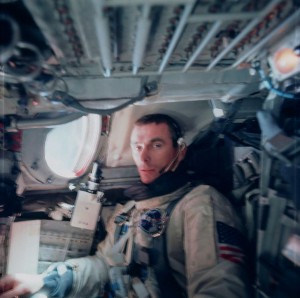
Finally gripping and pulling open the hatch, Cernan twisted himself and pushed his feet through the opening. Stafford manually reeled in the umbilical, then grabbed one of his suited ankles to anchor him back inside the cabin. As he tried to get back inside, Cernan inadvertently kicked the Hasselblad camera that Stafford had been using to photograph the EVA and it drifted off into space. “There went my still pictures,” he wrote later, “but I did retrieve the movie camera.”
Scrunching himself painfully into his seat, still fighting against the stiffness of the suit, he quickly found that he could not close the hatch. Eventually, with Stafford’s help, the pair managed to yank it down and Cernan pumped the handle until the hatch was secure. In his autobiography, he would admit that the pain was so intense that he cried aloud—“but only Tom really knows”—and came close to losing consciousness. Then, as Stafford began repressurizing Gemini IX-A’s cabin, Cernan felt the rigidity of the suit begin to soften and he was finally able to breathe properly and remove his helmet. The United States’ second spacewalk was over in two hours and eight agonizing minutes.
Exhausted, the beetroot-faced Cernan was doused with weightless droplets fired by Stafford from a water pistol, and strips of skin from his swollen hands tore away as he removed his gloves. He looked, wrote Stafford, “like he’d been baked in a sauna too long.” However, with the exception of the reaction he might get from the other astronauts, Cernan really did not care. He had endured the most traumatic spacewalk to date … and, astonishingly, had lived!
Less than a day later, at 9 a.m. EST on 6 June 1966, Gemini IX-A was bobbing in the Atlantic. Cernan described his first fiery re-entry through the atmosphere as “like a meteoric bat out of hell” and compared the spacecraft as having the aerodynamic characteristics of a bathtub as it plummeted Earthward. They splashed down close enough to their prime recovery vessel, the aircraft carrier U.S.S. Wasp, that they were able to offer and acknowledge thumbs-up signals with the ship’s crew.
Gene Cernan’s harrowing EVA would teach a harsh, yet valuable, lesson to those engineers, managers, and even astronauts who perceived extravehicular activity as a proverbial walk in the park. Why, some journalists asked him in the weeks that followed, was his spacewalk so difficult in comparison to Ed White’s graceful stroll? The key differences, of course, were that White had been equipped with a hand-held propulsion device and that, other than floating around, he was not actually given any specific tasks.
Yet Cernan’s problems—the shortcomings of his suit’s environmental controls, the fogging of his visor, the difficulties encountered when getting back into the spacecraft, the need for handholds, the impossibility of moving without a propulsion device—highlighted an urgent need for such issues to be rectified before the closure of the Gemini chapter in November 1966. Apollo managers, then hard at work preparing for the first flight of their spacecraft in the spring of 1967, also took heed: Future Moonwalkers could not operate on the lunar surface for many hours under such life-threatening conditions. It is quite remarkable, therefore, that by the time Cernan’s backup, Buzz Aldrin, completed his own EVAs on Gemini XII, the problems would have been virtually resolved.
This is part of a series of history articles, which will appear each weekend, barring any major news stories. Next week’s article will focus on Mission 51G, a shuttle flight of many changing faces, with no less than three nationalities aboard, back in June 1985.
Want to keep up-to-date with all things space? Be sure to “Like” AmericaSpace on Facebook and follow us on Twitter:@AmericaSpace




Poor Gene! I read also that he lost several pounds after that spacewalk.
I read his book. The part about getting back in Gemini was errieee.
The angry Alligator-Agena came just a year before the SPECTRE ship from YOU ONLY LIVE TWICE.
I wonder…